Для данной статьи доступны видео-рекомендации с сурдопереводом.
Содержание
1. Куда сохраняются скачанные из интернета файлы
Место сохранения загруженных файлов зависит от браузера.
Браузеры Интернет и Chrome: по умолчанию все скачанные из
интернета файлы сохраняются в папку Download (Загрузки), которая находится в памяти
устройства.
Другие загруженные браузеры: могут создавать свои собственные папки для сохранения загруженных файлов. Например,
UC Browser сохраняет файлы в Память устройства → Android →
data → com.UCMobile.intl → files → UcDownloads.
Обратите внимание: папка Android → data недоступна для просмотра на Android 11.
Куда сохраняются скачанные из интернета файлы – видео с сурдопереводом.
2. Как посмотреть содержимое папки Download
-
Откройте меню устройства.
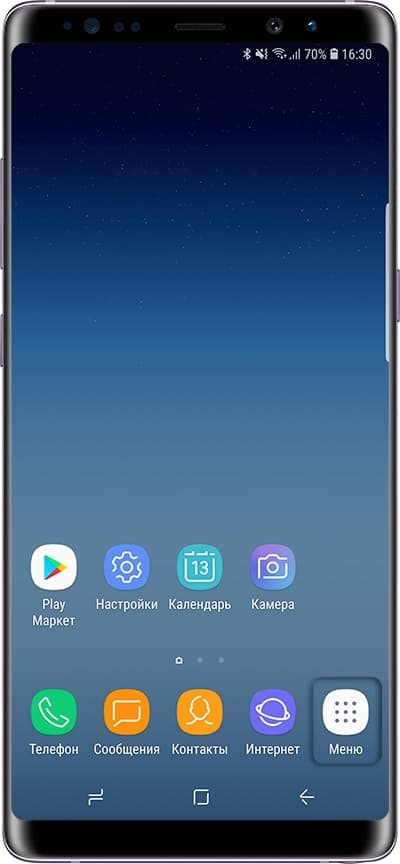
-
Выберите приложение Мои файлы. Часто оно находится в папке Samsung.
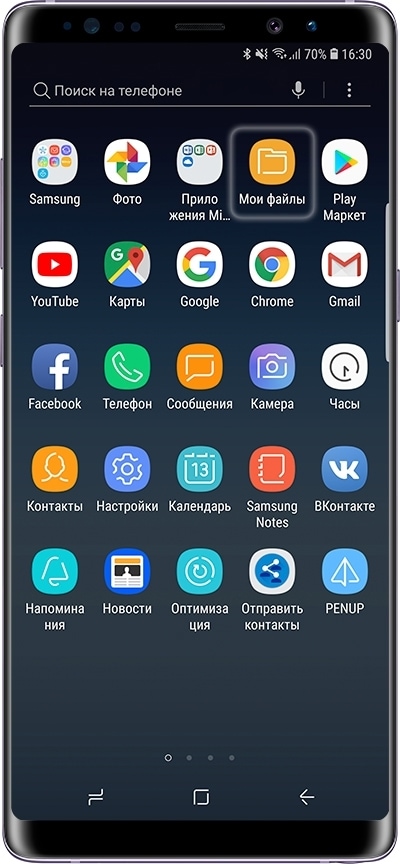
-
Выберите пункт Загрузки, если он есть на вашем устройстве.
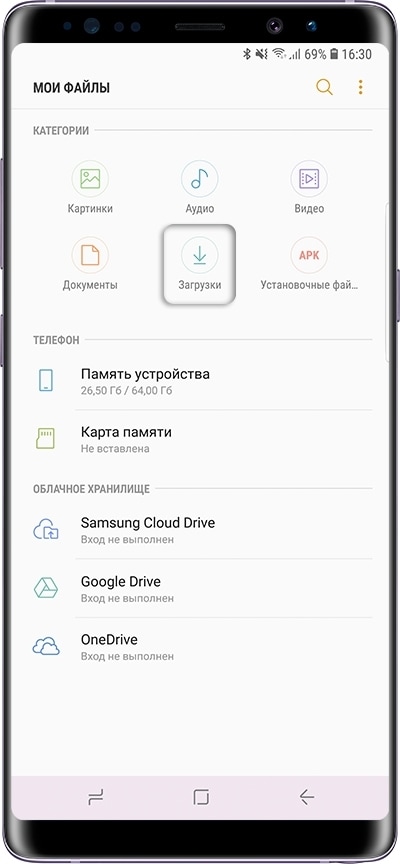
Если такого пункта нет, выберите Память устройства,
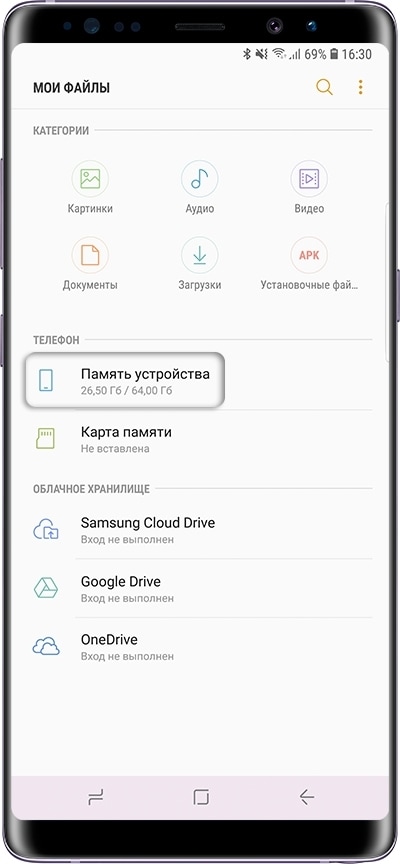
затем откройте папку Download.
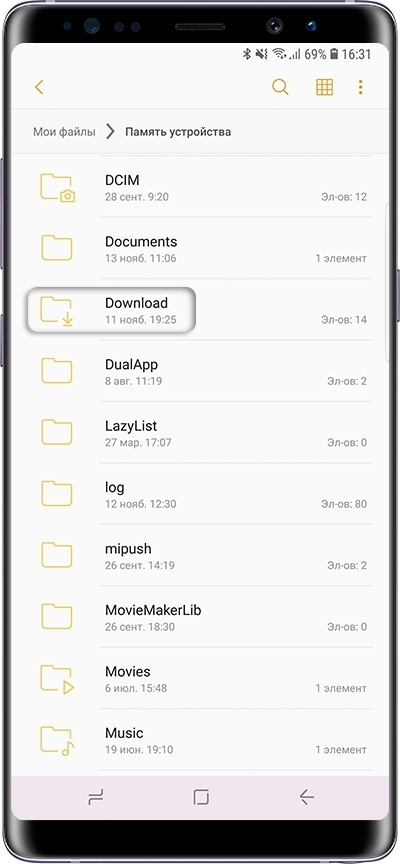
-
В папке появятся загруженные из интернета файлы.
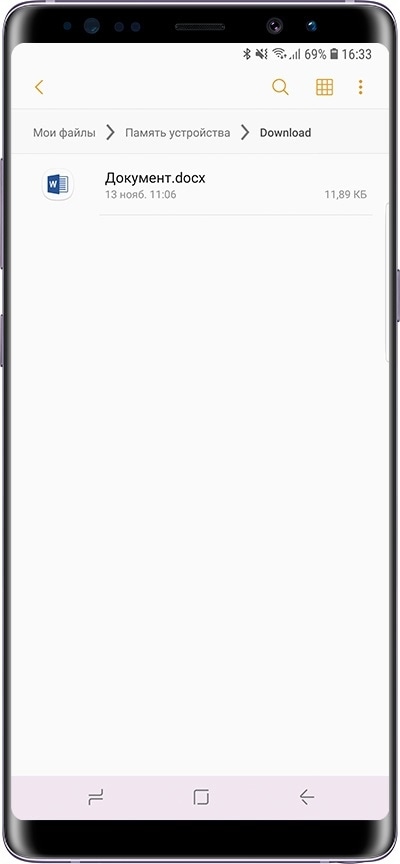
Как посмотреть содержимое папки Download – видео с сурдопереводом.
3. Как сохранять файлы из интернета сразу на карту памяти
В статье по ссылке ниже вы найдете инструкцию для стандартного браузера Интернет.
4. Не удается найти загруженные файлы в папке Download
Такое может быть только в одном случае — используется другой браузер, не Интернет или
Chrome.
Если не можете найти файлы, скачайте их с помощью браузера Интернет или Chrome.
Что делать, если не не удается найти загруженные файлы в папке Download – видео с сурдопереводом.
На сегодняшний день, в интернете можно скачать практически любые медиафайлы, например любимый сериал, кино, музыку, картинки, обои и.т.д Причем в большинстве случаев, абсолютно бесплатно.
Для такого рода объектов, в системе Андроид выделена специальная папка, которая так и называется Download, что в переводе на русский означает загрузки.
По умолчанию, она расположена во внутренней памяти устройства, и открыть её можно сразу несколькими способами.
Ниже в статье, я представляю два самых оптимальных варианта, в первом мы будем использовать родной файл менеджер, а во втором, зайдём в данный раздел с помощью браузера, с которого и производилась загрузка.
Внимание при необходимости, можно изменить папку загрузок, и скачивать любые объекты не во внутреннюю память, а на SD карту, как это сделать я рассказал здесь.
Как открыть скачанные файлы на Андроид телефоне Самсунг
- С помощью приложения Мои файлы
- С помощь браузера
С помощью приложения Мои файлы
1. Открываем меню приложений, и переходим в папку «Samsung», файловый менеджер обычно расположен именно там. 
2. Жмём на иконку «Мои файлы». 
3. На открывшейся странице, можно сразу перейти в нужный раздел, либо нажать на «Память устройства». 
4. Далее открыть соответствующую папку. 
5. Здесь хранятся нужные нам элементы. 
С помощь браузера
Пример будет показан на Гугл Хром, так как он является самым популярным мобильным веб-обозревателем, в остальных браузерах, принцип тот-же.
1. Жмём на соответствующую иконку. 
2. Далее открываем меню, нажав на кнопку «Три вертикальные точки».
3. Находим нужный пункт и открываем его. 
4. Буквально за пару кликов, мы добрались до нужного места. 
-
Home
- Mobile
If you have a Galaxy phone, you also have a My Files app … but you may not have used it yet. The Samsung My Files app is all about utility and managing storage, but users rarely need it unless something goes wrong. If you can’t locate a file on your phone, but you’re sure it was downloaded, this app can help. Likewise, if you want to transfer specific files from your computer to your phone (and vice-versa) but aren’t sure how to, the My Files app will prove necessary.
Let’s go over how to find the My Files app, and the useful things it can do for Galaxy phone users.
Finding the My Files app
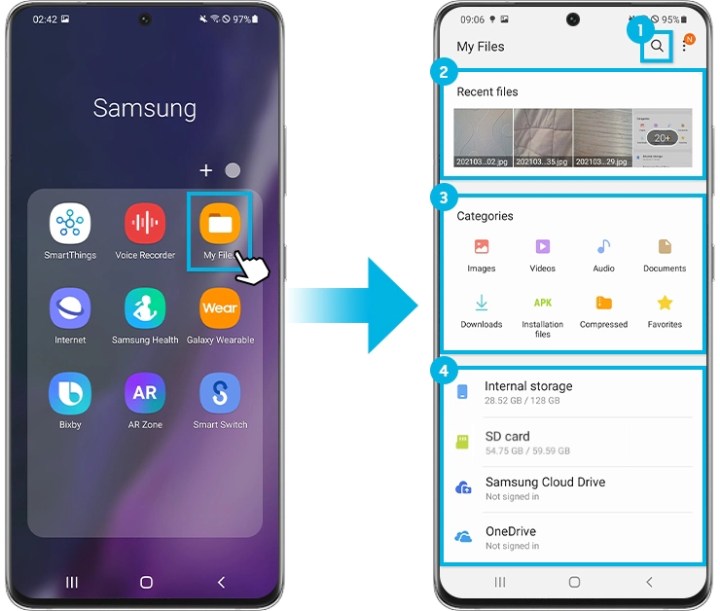
The easiest way to get to My Files is to open search and type in “my files.” If you want to do it manually, swipe up on your screen to reveal all apps and navigate to your Samsung folder. My Files should be in this folder.
When you open My Files, you’ll notice it’s divided into two sections. The top section is your main file management menu. You can see the different categories of files on your phone like Images, Audio, Documents, Downloads, and more.
The second section focuses on all your storage options, both local (the hard drive inside your Galaxy phone), external (another computer or external hard drive that you have connected via cable or card slot), and online (cloud storage that you are using to store and retrieve files). If you add a storage app like OneDrive, it will appear here.
The storage section allows you to enter your cloud storage and access the files you keep there, but it also lets you see how much internal storage you have left remaining.
Important My Files capabilities
Let’s break things down by taking a look at specific tasks My Files can help with, and problems that it can solve when using your phone.
Find a file you just downloaded

If you know you downloaded a file but aren’t sure where it ended up (it happens to all of us), just open up My Files and select Downloads. Allow your most recent downloads will appear here in chronological order, so you should be able to spot your file in the last few downloads.
This is also a good way to check when you know something was downloaded, but aren’t sure what it was. Sometimes the type of file can indicate if it may have been malware or another problem — just don’t open it if you aren’t sure.
Fix storage problems and clear space
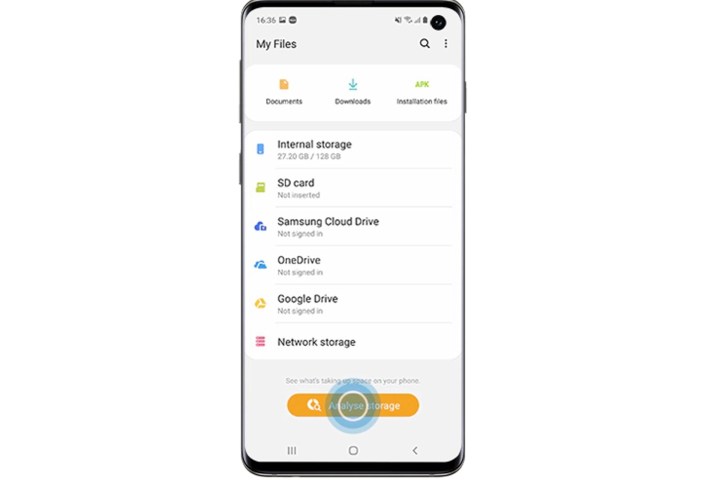
We mentioned that My Files can tell you have much storage space you have left, but it’s also a good way to manage storage when a problem occurs. If you’ve had your Galaxy for a while, you may be running out of storage space, which can also cause crashes, slow performance, and other issues. That’s a sign it’s time to head into My Files, scroll to the bottom of the app, and select Analyze Storage.
This will open a new window that will break down exactly what’s being stored on your phone. If your Recycle Bin has files in it, you can empty it to clear some space. Scroll down and you will be able to see notifications about any unused files, especially large files, or duplicate files that you can get rid of, too. Even the breakdown of file types on your Galaxy can help you know where to begin deleting files based on what’s taking up the most space (video is a common culprit).
Find a file that’s somewhere in cloud storage
If you move between multiple cloud storage apps, you may know that a certain file is in cloud storage, but not exactly where. The My Files app is one of the quickest ways to check. Just look in the storage section at all connected cloud storage drives, and pop each one open at a time to check on the files.
Move files to an SD card

First, you’ll need to have a compatible SD card installed in the Galaxy card slot: Certain models, such as the Galaxy S21, do not have an SD card slot and cannot transfer files this way.
Next visit My Files and you should see the SD Card appear in storage, right underneath Internal Storage. Use the Categories section to find the file you have in mind, then do a long press on the file itself. This will open up options to Move or Copy the file. Select Move, then back out and enter the SD Card section. You can navigate to a particular folder in SD Card if you want, but it’s not necessary. When ready, select Move Here at the bottom of the screen and your file will be deposited on the card.
Delete files

If you’re ready to delete a specific file, the My Files app makes it easy. When you find the file you want to get rid of, touch and hold the file with a long press until the file options appear at the bottom of the screen. Choose Delete, and the file will go to the trash for permanent deletion after 30 days.
Editors’ Recommendations
-
When is my phone getting Android 14? Here’s everything we know
-
How to know if someone blocked you on WhatsApp
-
Here’s our very first look at the Samsung Galaxy Tab S9 Plus
-
Does the Samsung Galaxy A54 have wireless charging?
-
When is my phone getting Android 13? Google, Samsung, OnePlus, and more

If it can be streamed, voice-activated, made better with an app, or beaten by mashing buttons, Tyler’s into it. When he’s not…
-
Mobile
Samsung brings the Galaxy S23’s new software to older phones

Samsung this week announced that it will be rolling out its latest One UI 5.1 software to current Galaxy devices, including the Galaxy S22, Galaxy Z Fold 4, and Galaxy Z Flip 4 lineups. The company debuted the Android 13-powered One UI 5.1 update on the Galaxy S23 Ultra this month, and it’s bringing those extra features to general users.
“One UI 5.1 is the up-to-date example of Samsung’s commitment to providing Galaxy users with the latest innovations as soon as possible,” Samsung’s Janghyun Yoon said in a blog post. “Over the past several weeks, we have worked closely with our service providers and carrier partners to bring One UI 5.1 to current Galaxy smartphones and tablets around the world within a few short weeks of the Galaxy S23 series announcement.”
Read more
-
Mobile
The best Samsung tablets in 2023: our 6 favorite picks

Samsung makes some of the best smartphones, but it also excels at making amazing tablets. It launched its first tablet — the Samsung Galaxy Tab — way back in 2010, and since then, it has expanded its lineup with premium models, budget models, and everything in between. If you’re new to its range of tablets, you may be a little bewildered by all of the choices on offer, so we’ve put together the best Samsung tablets to simplify things for you.
Looking for an iPad? Check out our list of the best iPads. If you’re open to any Android devices, check out our best tablet roundup.
Read more
-
Deals
The best Samsung Galaxy S20 deals for December 2022

Are you looking for Samsung Galaxy S20, S21, or S22 deals? Since Samsung introduced the Galaxy S22, this is a better time than ever to shop for cheap Samsung Galaxy S20 deals — and Galaxy smartphone deals are exactly what we’ve got. From the big-box online stores to mobile network service providers, we’ve combed the web to bring you all the best Samsung Galaxy S20 deals, bundles, and carrier offers available right now with discounts that can save you hundreds on a new Samsung Galaxy S20, S21, and S22 models. If you love all things Samsung and want to see what else is on offer at the moment, then head on over to these Samsung Galaxy Note 20 deals once you’re done here. We may see supply chain issues, shipping delays, low inventory, and even more materials shortages — like what’s happening with the computer chip market. If you’re ready to see what’s available, check out our top picks below.
Today’s best Galaxy S20 deals
Samsung Galaxy S20
Read more
08.06.2018 08.06.2018
На устройствах компании Samsung есть собственный встроенный файловый менеджер, его название «Мои файлы». «My Files» управляет всеми файлами на вашем смартфоне, так же, как файловый менеджер на вашем компьютере. В этой статье рассказывается о том, как просмотреть свои файлы в диспетчере файлов Samsung Galaxy.
О ЧЁМ СТАТЬЯ?
- Действия
- 1. Откройте список приложений вашего Galaxy
- 2. Нажмите папку Samsung
- 3. Нажмите «Мои файлы»
Действия
1. Откройте список приложений вашего Galaxy
![]()
- Сделайте это, нажав на значок с квадратом из крошечных квадратов или точек в правом нижнем углу экрана. Если у вас есть Galaxy 8, вместо этого проведите по экрану снизу от главного экрана.
2. Нажмите папку Samsung
![]()
- Если у вас нет этой папки, перейдите к следующему шагу.
3. Нажмите «Мои файлы»
![]()
- Это значок оранжевой папки. Теперь вы можете просматривать и папки на своем телефоне или планшете.
- Если вы не можете найти файловый менеджер, коснитесь панели поиска в верхней части окна приложения, введите мои файлы и нажмите «Мои файлы» в результатах поиска.
 В интернете, где как говорится, «есть всё», и вы можете скачать на ваш смартфон музыку, видео, фотографии, документы и ещё много чего. То, что вы скачиваете из интернета, на смартфоне хранится в виде файлов.
В интернете, где как говорится, «есть всё», и вы можете скачать на ваш смартфон музыку, видео, фотографии, документы и ещё много чего. То, что вы скачиваете из интернета, на смартфоне хранится в виде файлов.
Этими файлами вы также можете поделиться и со своими друзьями, переслав их по электронной почте, или ещё какими-нибудь иными способами, о которых мы будем говорить позже.
А когда они станут вам не нужны — вы можете их удалить, освободив место под новые файлы.
Для этого существует специальная категория приложений, которая называется «Файловые менеджеры». Они созданы для поиска файлов, для их копирования, изменения их наименования, удаления и прочее.
На смартфоне SAMSUNG такое приложение носит название «Мои файлы».
Итак, запускаем приложение «Мои файлы». Но вначале это приложение нужно найти. Для этого:
1. С Главного экрана переходим на «Экран приложений». Для этого нужно сделать свайп от центра экрана либо вниз, либо вверх экрана.

2. На «Экране приложений» нужно войти в папку «Samsung».

3. Запускаем приложение «Мои файлы».

4. Все скаченные файлы из интернета находятся в папке «Загрузки», а их копии ещё разложены по своему назначению в соответствующих папках, которые для удобства поиска выставлены в виде иконок на экране: «Изображения», «Видео», «Аудио», «Документы» и т.д.
Нажимаем на значок «Загрузки».

5. После этого мы получаем доступ ко всем загруженным файлам.
Оказалось, что в папке «Загрузки» находится только один файл: «deti-online.com_-_mishkina-kasha.mp3». Этот mp3-файл является аудио-книгой Николая Носова «Мишкина каша».

6. А что мы можем сделать с этим файлом?
Первым делом: запустить его.
Для этого просто нажимаем на него один раз.
Наш умный смартфон хорошо разбирается в типах скаченных файлов. Поэтому при запуске именного этого mp3-файла он загрузит приложение для воспроизведения музыки и уже из него запустит сам файл на воспроизведение.

7. Вторым делом: а если нажать на файл и удерживать на нём палец некоторое время, то этот файл будет «отмечен» и появится метка в виде жёлтой галочки.
Тогда вы сможете произвести и другие операции с этим файлом, а именно:
— Переместить;
— Копировать;
— Узнать Свойства файла;
— Поделиться;
— Удалить.
Значки этих операций находятся в нижней строке экрана.

8. Если нажать на значок «Ещё» в виде трёх точек, расположенного вверху экрана, то вы сможете:
— Переименовать;
— Добавить ярлык;
— Переместить в «Защищённая папка»;
— Открыть с помощью.

